The Apple Thunderbolt Display Review
by Anand Lal Shimpi on September 23, 2011 2:56 AM EST- Posted in
- Displays
- Mac
- Apple
- Thunderbolt
- Thunderbolt Display
Ever since I moved to a notebook as my main work computer I've become increasingly annoyed with the process of actually moving my notebook-as-a-desktop around. At my desk I've got DisplayPort, Ethernet, two USB, FireWire 800, speakers and power all plugged into a 15-inch MacBook Pro. What makes it frustrating isn't the first-world-problem of having to unplug seven cables, rather that it doesn't need to be seven cables - Apple could make the whole thing happen with just two.
Every Mac released in 2011 has at least one Thunderbolt port (the iMac has two), and Thunderbolt can deliver exactly what I'm looking for. Thunderbolt can carry two things: PCI Express and DisplayPort, the former for data and the latter obviously for video. Why would you want to carry PCIe and DP over a single cable? To address problems like the one above.
Pretty much all device expansion on modern day PCs happens via PCI Express. Several years ago it was hard to find PCIe sound cards or Ethernet controllers, but these days vanilla PCI slots are nearing extinction and PCIe is the de facto standard. Ethernet, USB and FireWire controllers all exist as single-lane PCIe devices. Put a bunch of them at the other end of a Thunderbolt cable and you no longer need to plug in a bunch of individual cables into your notebook when at your desk. Send DisplayPort over the same cable and you can actually move all of those ports onto your monitor, thereby using a single cable to carry everything but power to your display. And this is exactly what Apple has done with its new Thunderbolt Display. By mating its 27-inch LED Cinema Display with a bunch of integrated IO controllers, Apple is hoping to deliver a display that's more of a mobile docking station than just a passive way to display video.
Apple has tried this in the past. The old Cinema Displays used to feature an Apple Display Connector (ADC) that actually carried DVI, USB and power from a desktop Mac to the monitor. You only needed to plug in a single cable to your display, significantly reducing desktop clutter. Although Thunderbolt does carry power, it's limited to 10W - not enough to power any reasonably sized display. Where Thunderbolt does win out over ADC however is in its universal appeal. Intel created the standard. Although it's used almost exclusively on Apple systems today, come 2012 Intel is expecting PC OEMs to embrace the interface with its Cactus Ridge line of Thunderbolt controllers.

Apple's Thunderbolt Display
The Thunderbolt Display uses a near, if not perfectly, identical panel to what was in last year's 27-inch LED Cinema Display. You get a 27-inch, 16:9, 2560 x 1440 LED backlit display capable of at least 350 nits at full brightness. Apple seems to conservatively spec its desktop displays as we were able to measure 425 nits at max brightness. The uber brightness comes in handy because the display does have a glossy finish. Indoors it's not really a problem unless you're watching a dark movie scene with the display lit by a sun-facing window. Even then, cranking up the brightness all the way is usually enough to overcome any significant glare. As with all glossy displays, if you have light control (e.g. curtains or blinds) you'll be just fine.
The similarities don't end with the internal panel, the chassis is very similar to its older sibling and the Thunderbolt Display retails for the same $999 price.
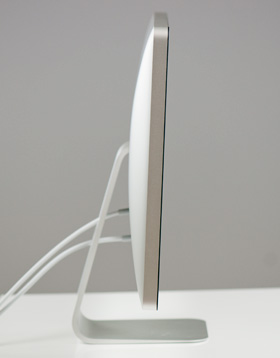 |
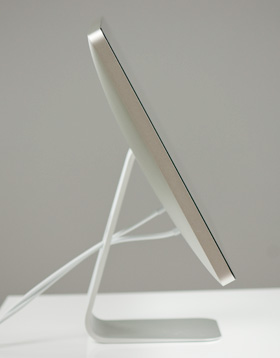 |
The display sits on an aluminum swivel base that allows for -5 degrees to 25 degrees of tilt along the horizontal axis. There's no height adjustment for the display either, only tilt. Personally, I use a height adjustable desk as I find it helps me avoid any carpal tunnel pain. Combined with a height adjustable chair, the lack of height adjustment on the display doesn't bother me. If you have a fixed height desk however, this may be a problem.
Aesthetically the Thunderbolt Display continues Apple's aluminum meets glass design language. The front of the display is all glass, while the edges and back are all aluminum. Along the top surface of the display is a mic for the integrated FaceTime HD camera. The outgoing 27-inch LED Cinema Display (still available for purchase online) sported a 640 x 480 camera, while the Thunderbolt Display ups capture resolution to 1280 x 720.
There's an ambient light sensor hidden in the top bezel of the display, but as always you can disable its functionality from within OS X.

There are two integrated speakers in the display, again unchanged from the previous LED Cinema Display.
Two cables attach directly to the display: a removable power cable and an integrated IO cable. Cable management is done through a round cutout in the aluminum stand. The IO cable is where things really change with the Thunderbolt Display. Instead of a breakout of three cables as was the case with the Cinema Display, there are now only two: MagSafe and Thunderbolt.
The MagSafe connector remains unchanged. If you've got any Mac that can be charged by an 85W MagSafe adapter, the Thunderbolt Display will charge said Mac. This feature alone is particularly awesome for notebook-as-a-desktop users since it allows you to just keep your actual AC adapter tucked away in your travel bag. For me I keep my MagSafe adapter in my bag and never take it out so I never have to worry about forgetting to pack it. Given how expensive MagSafe adapters are ($79 for an 85W), this is a nice feature for MacBook Air/Pro owners.
The Thunderbolt cable is obviously what gives this new display its name. Inside the Thunderbolt Display is an Intel Light Ridge Thunderbolt controller. The type of controller is important as it bestows upon the display some clear limitations. The biggest of course is the lack of support for all non-Thunderbolt systems. That's right, the only way to get video to the Thunderbolt Display is by using a Thunderbolt enabled Mac (or theoretically a Thunderbolt enabled PC). For Mac users that means only 2011 MacBook Pro, Air, iMac or Mac mini models will work with the Thunderbolt Display. Everyone else has to either buy a new Mac or stick with older displays.
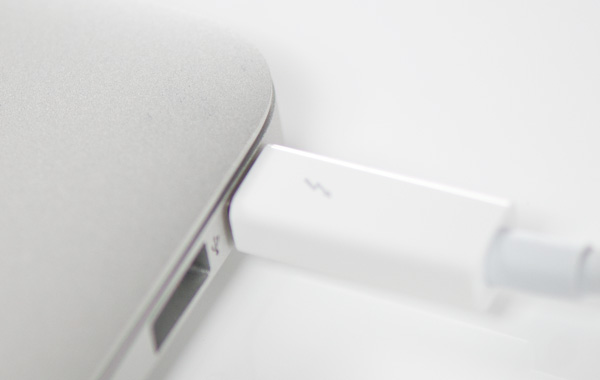
I believe the limitation here is actually on the cable side. A Thunderbolt cable can only transmit a Thunderbolt signal. Although DisplayPort is muxed in, if the display on the other end is expecting Thunderbolt and it receives DisplayPort it won't know what to do with it. It's possible Apple could have built in logic to autosense and switch between Thunderbolt and DisplayPort as inputs, but Apple traditionally employs clean breaks rather than long technology transitions. If Apple wants to ensure Thunderbolt gets adopted (at least by its users), this is the way to do it. As we learned from other legacy interfaces (e.g. PS/2, IDE), if you enable backwards compatibility you'll ensure the survival of systems that implement those interfaces. It's not so great for existing customers unfortunately.


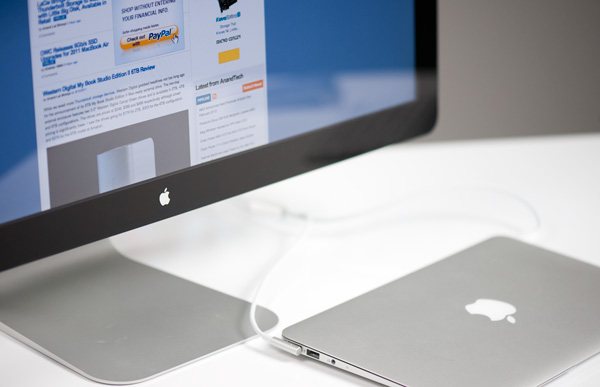
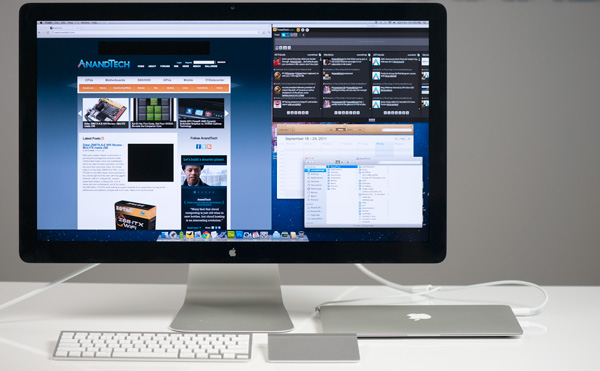
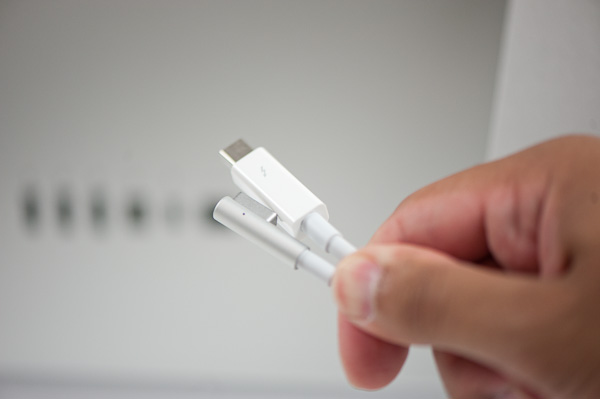








275 Comments
View All Comments
Anand Lal Shimpi - Friday, September 23, 2011 - link
We do not accept payment for any review, this one included.Take care,
Anand
Anand Lal Shimpi - Friday, September 23, 2011 - link
I needed to start somewhere :) The next video review won't be an Apple product ;) And we do try to take great photos of everything we review when possible. I believe some of the best photos to-date have been of Android smartphones imho done by Brian Klug.Take care,
Anand
Aikouka - Saturday, September 24, 2011 - link
It's a good review overall, but I do have a comment or two:- When switching to a completely different view, I would recommend using a quick transition such as a fade. It's rather jarring to just suddenly switch to a completely different picture like that.
- If you'd like to make video reviews a bit more common, it might be worthwhile to consider a slight site change to make them a bit more accessible. Some sort of thing (tabs, buttons, etc.) near the top to switch between a text review and a video review.
I'm trying to figure out though... did you build that entire stage area for the review, or is that a blue screen behind you? The shadows on the lettering made me wonder.
G-Man - Friday, September 23, 2011 - link
I'm guessing they make the extra effort on Apple-products, simply because A LOT more people read those articles than the odd generic laptop review.If you've been following Anandtech for a while, you will see that they recap and explain (basic) technology and concepts in Apple review, because more people read them, and less tech savvy people read them.
So it's only natural for them to put extra effort into Apple-reviews.
PS: Anand, LOVE the video review. Please keep making them! :)
gevorg - Friday, September 23, 2011 - link
Anandtech just loves Apple products, hence the special treatment. :)MrX8503 - Friday, September 23, 2011 - link
Maybe you're the fanboy. Its a good review just like any other, accept it.KoolAidMan1 - Monday, September 26, 2011 - link
B3an is definitely the fanboy, there is massive bias when he posts in DT threadsKoolAidMan1 - Friday, September 23, 2011 - link
Part of it is that Apple products generally photograph better than others. It is hard to polish a turd, no matter how well you frame or light it. On the other hand, a beautiful object can photograph well under most circumstances.As for effort into reviewing Apple products, it is generally because they are on the leading edge of physical interfaces, form factors, and technologies. Three years after the debut of the Macbook Air and now there is a massive push from other companies to deliver comparable machines.
The reasoning behind the Thunderbolt review is that it points to a very probable future for PCs, one in which your laptop is also your main computer. One option will be to have a laptop that plugs into a Thunderbolt hub (which may or may not be integrated into a display) which has all of your external devices and other things such as a dedicated desktop GPU, etc etc.
It is interesting how much anti-Apple bias there is here. I'm typing this on my PC but I"m not blind to how vital Apple is to the industry.
seapeople - Friday, September 23, 2011 - link
You're comparing the reviews Anand does himself to what some of the other editors do for cheaper/less advanced products. Look at Anand's SSD reviews (especially when its for a new/unique controller) and you'll see the same detail.Kristian Vättö - Saturday, September 24, 2011 - link
And at the same time, many SSD reviews consist of just benchmarks and a small introduction. Take for example the Samsung 830 SSD review, it's not that massive, mainly because Samsung isn't that big player.